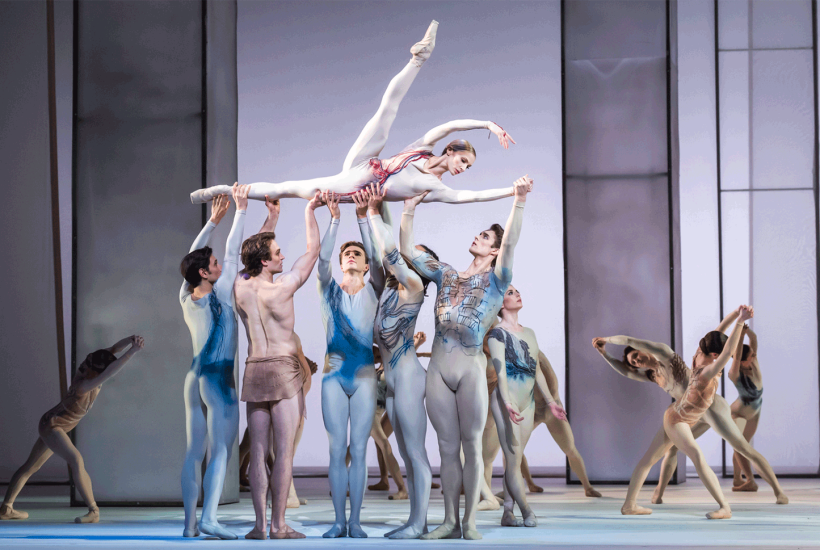My feelings about the genius of Kenneth MacMillan have always been volatile, but in the course of the Royal Ballet’s current triple bill, they veered even more wildly than usual between uncomplicated delight, awed reverence and embarrassment.
A revival of his early Danses Concertantes, firing off Stravinsky at his most effervescent and designed with exuberantly colourful Festival-of-Britain jazziness by Nicholas Georgiadis, provided half an hour of pure joy. Stylistically an exercise in the neoclassicism that dominated the postwar era, it’s witty, chic and upbeat, exploring sharp angles rather than smooth curves and lyrical lines. MacMillan’s choreographic invention is profligate, with little twists and unexpected turns, all infused with an infectious spirit of playfulness. Among a sparkling ensemble, the mercurial Sae Maeda and Luca Acri shine brightest, but classically noble Vadim Muntagirov looked a bit lost.
Amazingly, it never sinks into religiose kitsch: it simply looks up towards the light. Wonderful
Bordering on the sublime is Requiem, which runs the gamut of the emotions of mourning, inspired by Fauré’s gently solemn setting of the mass and the premature death of MacMillan’s confrère John Cranko. Grief, rage and acceptance, absence and loss, even a child’s dream of heaven: MacMillan paints them all with exquisite sensibility, drawing on the compositions of William Blake and baroque masters to create both fluent images of grace and frozen tableaux of the pietà. Yolanda Sonnabend’s designs are chastely perfect: translucent fibreglass columns against a pale blue backdrop, matched with minimal costumes. William Bracewell is a Christ-like figure of agony, imploring mercy; Lauren Cuthbertson is the consoling angel. Amazingly, it never sinks into religiose kitsch: it simply looks up towards the light. Wonderful.
But I can’t buy Different Drummer, MacMillan’s adaptation of Woyzeck, clumsily manacled to Webern’s Passacaglia and Schönberg’s Verklärte Nacht. Spare me all those Joy of Sex leg-over contortions and German expressionist clichés – gas masks, silent screams, manic militarism, slutty whores and so forth. It may be meant to be boldly provocative – look how nasty and grubby ballet can be – but the effect is merely jejune. I hated every minute of it. Full marks, however, to Reece Clarke, usually an inhibited actor, who throws himself wholeheartedly into the title role; Natalia Osipova is sadly rather wasted as his mistress Marie. Super orchestral playing under the admirable conducting of Koen Kessels energised the entire programme.
Kidd Pivot, the collaborative venture led by the Canadian choreographer Crystal Pite and playwright-director Jonathon Young, returns to London with another remarkable exercise in an idiom that is like nothing else I’ve ever witnessed. Using movements that have something of the nanosecond precision of stop-motion animation, the dancers mime in meticulous lockstep to a pre-recorded spoken text. This transcends superficial comedy to open up an expressive vocabulary of its own, and a weirdly compelling one too.
Assembly Hall draws on the premise of Wagner’s Parsifal. A group of dedicated amateurs have been gathering for years in a village hall to re-enact medieval battles and quests. But the enterprise is failing, for loss of funds and faith, so there’s a vote on dissolution, wittily satirising committee procedure. A lone voice cannot accept defeat. Amid the argy-bargy, we are gradually drawn into a sphere in which those medieval enactments become muddled with reality – Monty Python and the Holy Grail meets Lewis Carroll, one might say: with knights in armour, damsels in distress, Excalibur and the Chapel Perilous all evoked. Immaculately performed by a cast of eight, it’s madly ingenious, often bizarrely funny and sometimes surprisingly beautiful.
Do I really understand what it is getting at? Not after a first viewing, to be honest. But I do know that I’d love to dig deeper and see it again.
Got something to add? Join the discussion and comment below.
Get 10 issues for just $10
Subscribe to The Spectator Australia today for the next 10 magazine issues, plus full online access, for just $10.
You might disagree with half of it, but you’ll enjoy reading all of it. Try your first month for free, then just $2 a week for the remainder of your first year.








Comments
Don't miss out
Join the conversation with other Spectator Australia readers. Subscribe to leave a comment.
SUBSCRIBEAlready a subscriber? Log in